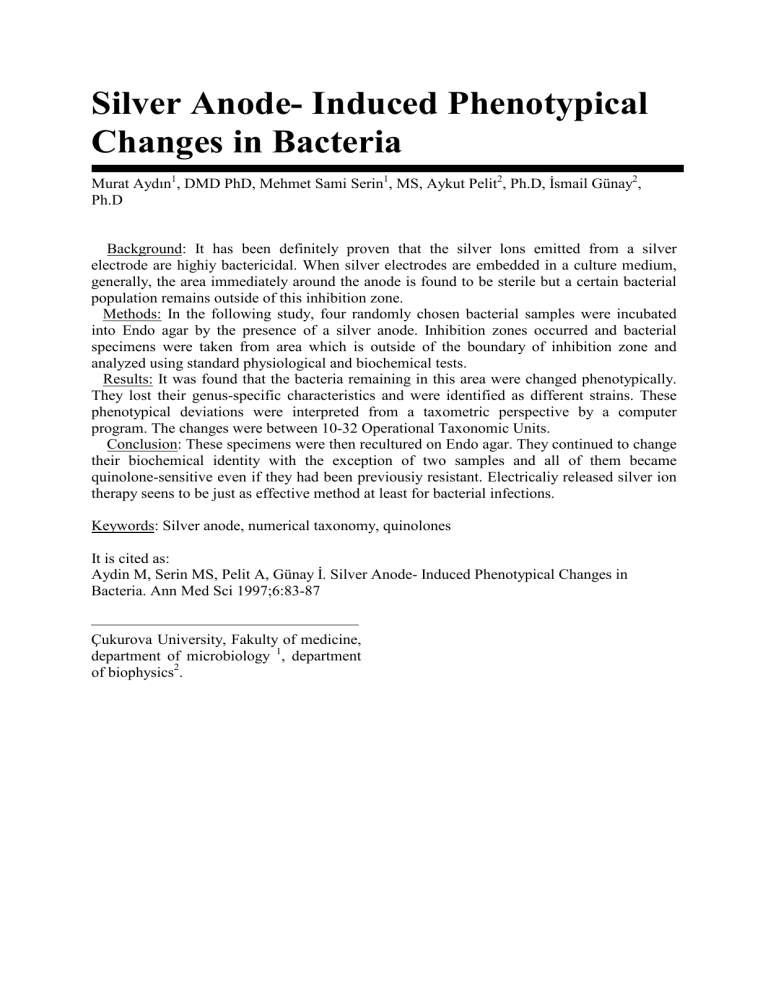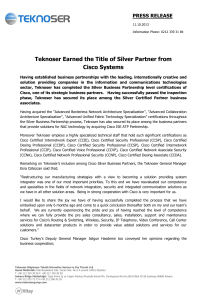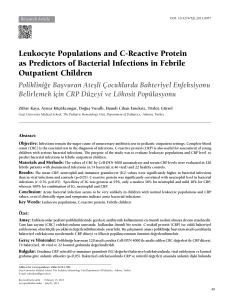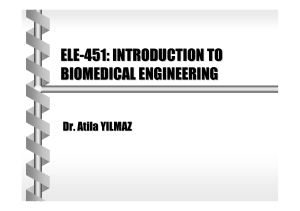
Silver Anode- Induced Phenotypical
Changes in Bacteria
Murat Aydın1, DMD PhD, Mehmet Sami Serin1, MS, Aykut Pelit2, Ph.D, İsmail Günay2,
Ph.D
Background: It has been definitely proven that the silver lons emitted from a silver
electrode are highiy bactericidal. When silver electrodes are embedded in a culture medium,
generally, the area immediately around the anode is found to be sterile but a certain bacterial
population remains outside of this inhibition zone.
Methods: In the following study, four randomly chosen bacterial samples were incubated
into Endo agar by the presence of a silver anode. Inhibition zones occurred and bacterial
specimens were taken from area which is outside of the boundary of inhibition zone and
analyzed using standard physiological and biochemical tests.
Results: It was found that the bacteria remaining in this area were changed phenotypically.
They lost their genus-specific characteristics and were identified as different strains. These
phenotypical deviations were interpreted from a taxometric perspective by a computer
program. The changes were between 10-32 Operational Taxonomic Units.
Conclusion: These specimens were then recultured on Endo agar. They continued to change
their biochemical identity with the exception of two samples and all of them became
quinolone-sensitive even if they had been previousiy resistant. Electricaliy released silver ion
therapy seens to be just as effective method at least for bacterial infections.
Keywords: Silver anode, numerical taxonomy, quinolones
It is cited as:
Aydin M, Serin MS, Pelit A, Günay İ. Silver Anode- Induced Phenotypical Changes in
Bacteria. Ann Med Sci 1997;6:83-87
Çukurova University, Fakulty of medicine,
department of microbiology 1, department
of biophysics2.
Silver compounds are used to treat eye
infections and burn wounds topically as
bacteriostatic agents. When a pure silver
metal is polarized using electricity, silver
ions are emitted from the electrode surface.
İt is found that positively polarized silver
ions are approximately 100 times more
lethal for bacteria than nonpolar silver.1
The same bacterial inhibition cannot be
obtained by using an equal amount of
silver without an electric current. The term,
silver anode (SA), means a positively
driven
pure silver electrode.
Its
antibacterial effect has a large spectrum
which includes many facultative bacteria
and anaerobes.1-7 Of the metal electrodes
(Ag,Pt,Au,Cu and steel) tested, only silver
anodes were inhibitory at low currents.7,8
Moreover, the anodic silver ions are
also found to be antifungal and antiviral
both in-vitro and in-vivo.1,2,9 However, the
mechanism causing this effect is not yet
fully understood. Further, the antibacterial
effect of emitted silver continues even
when the electric current is stopped. If low
electric current is applied to silver
electrodes after incubation of the seeded
agar plate, a zone of inactive bacteria is
created, which upon subculture are not
viable.2 This demonstrates that, the silver
anode is bactericidal as well as inhibitory.
In contrast to the anode, the silver cathode
contributes to osteogenesis, but not
microbicidal.8,10
SA has been used in the treatment of
deep bone infections in orthopaedics.11,12,13
There has been no indication of deleterious
or irreversible effects on mammalian cells
unless the current exceeds 2 coulombs per
day. It has been found to be noncarcinogenic, non- antigenic and minimally
toxic when implanted in living tissue at a
current of 5-20 µA.3,8,11,13,14
It is well known that, when SA is
applied to living bacteria in a culture
medium, a large inhibition zone appears
around the anode after an incubation
period. Generally, the inner part of the
inhibition zone is found to be sterile.
Whether or not the phenotyoic profiles of
the bacteria remaining outside the zone
were changed has not been investigated
taxonomically.
In this study, the phenotypic profiles
and antibiotic susceptibilities of four
bacterial samples in the presence of a silver
anode were compared before and after
silver anode applied into the culture
medium. The observed changes were
interpreter program.
Materials and Methods
Citrobacter freundii (B1), Enterobacter
aerogenes (B2), Pseudomonas aeruginosa
(B3) and Proteus vulgaris (B4) were
isolated from specimens taken from
patients and purified. Each of the samples
was prepared using3 ml of broth medium
(GIBCO 1-t-1904) containing exponentialphase bacteria (optical density in the range
of 0.11 to 0.20 at 460 nm, 4 x 104 - 105
CFU) One ml of the bacterial suspensions
was of Endo nutrient agar at approvimately
45 oC. Each solution was blended and
equally divided into two standard petri
dishes, ane of which contained no
electrodes and served as the control. All
the dishes were incubated for 48 hours.
The surface area of each electrode was 0.4
cm2, the direct constant current was 15µA,
the thickness of the agar was 3 mm, the
total charge was 1.29 coulomb per day and
the charge density was 3.24 coulombs per
cm2 for each electrode. The electrode
posilion and experimental setup has been
described previously.15
Bacterial samples were taken from
the control plates (first example) and from
the SA treated plates near the boundaries
of the inhibition zones (second example).
Then, each of the second examples of four
bacterial samples were recultured without
electricity for 48 hours. These growths
represented the third examples of the
bacterial samples.
Standard
physiological
and
biochemical
tests
and
antibiotic
susceptibility tests were performed on each
of the three examples of the four bacteriall
samples. The test patterns are shown in
Table 1 and Table 2.
Table 1. Standard physiological and biochemical tests which were performed on the three
examples of the four bacterial samples, C. frenduii (B1), E. aerogenes (B2), P. aeruginosa
(B3), P. vulgaris (B4). Two of four bacterilal sample phenotypes (B1 and B2) highly deviated
after silver anode (SA) treatment. 1st, 2nd, and 3rd examples represnt the initial, after SA
treatment and subsequent generation respectively. (+, positive; -, negative;?, difficult to decide
test results)
Table 2. The antibiotic susceptibility test results of four bacterial samples before (1st
example), after (2nd example) silver anode application and their recultured forms (3rd
example). They gave almost completely to be sensitive to quinolone group antibiotics after
silver anode treatment.
C. frenduii (B1), E. aerogenes (B2), P. aeruginosa (B3), P. vulgaris (B4).
B3 and B4 almost completely returned
to their initial phenotypes in their third
examples. The antibiotic susceptibility
tests
indicated
that
quinolone
(ciprofloxacin) sensitivity was rather
enhanced in the third examples of all
samples despite the fact that the samples
became resistant in their first examples to
quinolones (Table.2.) Third examples of
B3 and B4 acquired a pronounced
resistance to all antibiotics except to
quinolone.
Although,
tetracycline,
penicillin, netilmicin, ceftazidime and
ampicillin sensitivities did not show
significant alterations for all bacterial
specimens.
Assessment of the results was made by
a computer program which was prepared
using the Quick Basic 4.5 and assembler
software language.16 This computer
program includes the phenotypic profiles
of 431 clinically important bacteria (207
Gram negative) based on sixty- two
standard physiological and biochemical
test responses of bacteria. It is capable of
placing an unknown bacteria in the
bacterial phenogram when the user inputs
its biochemical test responses. Also, it is
capable of calculating the taxonomic
distance of two bacteria by means of their
phenotypic characteristics by the following
formula:d2 = 1 –(OTU X 10-2) where d =
taxonomic distance; OTU = Operational
Taxonomic Unit (percentage similarities).
Results
After incubation, inhibition zones
appeared around the anodes in all four
dishes. The radius of the inhibition zones
varied from 20 to 24 mm around all anodes
(Fig 1). No corrosion or colorization was
observed on the surfaces of either the
anodes or the cathodes. End of experiment,
15 µA of current was still delivering
despite
medium
impedances
were
increased 23 +- 5 Ω because of ion
saturation on the electrode surfaces.
The phenotypic characteristics of the
bacterial samples changed, but their Gram
reactions and colonial morphologies did
not. The alteration of phenotypic identities
of the bacterial samples can be seen in
Table 1. If the phenotypic profiles of
samples are considered by themselves, it
suggests the following results;
4. respectively.
Figure 1. The inhibition zones around the
silver anode. A certain partial inhibition
zone can be observed around the clear
inhibition zone. The material which is
taken inside the inhibition zone is found
our to be sterile.
1. Citrobacter freundii was identified as
Salmonella arizona subgroup 3 B in
its second example with 18 OTU
between them, and as Enterobacter
asburiae in its third example with a
difference of 32 OTU.
2. Enterobacter
aerogenes
was
identified
as
Enterobacter
intermedium in its second example
with a distance of 14 OTU and as
Actinobacillus suis in its third
example with a distance of 30 OTU.
3. B3 and B4 were both briefly
depressed in their second examples.
Pseudomonas
aeruginosa
was
identified
as
Alcalifaciens
denitrificum and Proteus vulgaris as
Proteus penneri in their second
examples with 12 and 10 OTU
between their first examples
Discussion
Inside of the inhibition zone, the anodic
silver concentrations alter from 0.9 to
280.3 µg/ml and are sufficient for
antibacterial action.15 Many factors
operate in this area. In bacterial cells, the
oxidation of glucose, glycerol, fumarate,
succinate, D- and L-lactate are inhibited
by silver ions.17 Enzymes are inactivated
and free sulphydryl groups and NAD are
oxidized, ATP is destroyed17, but DNA
shows no molecular distortion.18
Consequently, both the respiration and
energy metabolism of the bacteria
collapses.17,19,20
Also,
certain
pleomorphism,
pili
defects,
and
vacuolizations15
and
mesosomal
dysfunctions appear in the bacterial cell
after SA treatment.1
However,nearby or outside the
nhibition zone, the silver concentration
is not completely lrthal for bacteria.
Nevertheless, the electric current spreads
over the entire agar medium. For this
reason, it can be concluded that the
phenotypic changes in the bacteria are
produced mainly by electricity.
An electrical potential already exists
on the surface of bacterial cells (zeta
potential). These charges on the
membrane reflet the interent genetic
expression (DNA content) and are
specific to bacterial species. It is most
likely that the bacterial DNA is affected
by the alteration of surface charge
during
external
electrical
interventions.21,22 Some species can
undergo genetic changes to a nearby
species under different environmental
conditions.23 Also, both ATP and
cytoplasmic content can leak out when
bacterial cells are exposed to electricity.
These
leaks
lead
to
an
electrotransformation process which is
correlated
with
electropermeabilization.21,22
In
this
study, al of the phenotypic changes of
the treated samples may not be real
genetic transformations. Nevertheless,if
these changes had occurred bacause of
phenotypic adaptation only, then all
silver anode treated strains would have
returned to their initial phenotypes after
they were incubated without electricity.
However, the phenotypes of both B1
and B2 were apparently changed by SA
application even though they were
hypothethic members of their own
genus. The phenotypes of B3 and B4
were briefly depressed only in their
second examples and then they almost
completely returned to their initial
phenotypes. Aydın et al. Demonstrated
that P. aeruginosa showed vauolization
and pili defects but did not changed
phenotypically under same condition.15
Already, both B3 (P. aeruginosa) and B4
are centrotype microorganisms and they
were less affected than B1 and B2. The
question of whether these changes are a
genotypic or a phenotypic adaptation
will remain until DNA sequence analysis
is performed on such bacterial species.
Meanwhile, the term ‘ Identity Crisis’
will be used to describe these genusspecific deviations.
It has been frequently demonstrated
that direct or alternating electric currents
increase the permeability of cellulas
Low
electrical
membranes.20,21
applications readily amplify the biocidal
effect of antibiotics on bacteria in
similar ways. The quinolone molecule is
attracted by silver. The Sulfo-Quinolone
Fluorescence Technique is a well known
practical method used in the microanalysis of silver.24 On the other hand,
the quinolone molecule’s proximity to
DNA is necessary for the biocidal effect
as it migrates through the medium and
cellular barriers by an active transport
mechanism.25 It has been proven that the
major proportion of the sılver present
was bound to the bacterial DNA (40
µmol Ag per 100 mg DNA).18 It is
possible that the bound silver on
bacterial DNA plays an important role in
the attraction and orientation of
quinolone molecules toward bacterial
DNA.
Our results showed that the selfatavistic structures of the bacteria were
obviously disturbed and that most
bacterial strains became sevsitive to
quinolone by silver anode application
even if they had been previously
resistant. Thus, electrically released
silver ion therapy seems to be just as
effective method at least for bacterial
infections.
Acknowledgement: Many thanks to
Dr. Pauline Aksungur for advising,
reviewing and corrections.
References
1. Berger TJ,Spadaro JA, Chapin
SE, Becker RO. Electrically
generated
silver
ions:
quantitative effects on bacterial
and mammalian cells. Antimic
Agents
Chemotherapy,
1976;9:357-8.
2. Spadaro JA, Berger TJ, Barranco
SD, Chapin SE, Becker RO.
Antibacterial effects of silver
electrodes with weak direct
current. Antimic Agents and
Chemotherapy, 1974;6:637-642.
3. Spadaro JA, Webster DA, Chase
SE. Direct current activation of
bacteriostatic silver electrodes.
3rd Annual meeting BRAG Soc.,
California, October 1983.
4. Spadaro JA. Silver anode
inhibition
of
bacteria.
Proceedings of Int. Congree on
Gold and Silver in Medicine.
Syracuse,1987.
5. Uezono H. Effect of weak direct
current with the silver electrodes
on bacterial growth. J Jpn Orthop
Assoc, 1990;64:860-867.
6. Falcone EA, Spadaro JA.
Inhibitory effects of electrically
activated silver material on
cutaneous
wound
bacteria.
Plastic and Reconstructive Surg,
1986;77:455-458.
7. Barranco SD, Spadaro JA,
Berger TJ, Becker RO. In vitro
effect of weak direct current on
Staphylococcus aureus. Clin
Orthop Rel Res, 1974;100:250255.
8. Spadaro JA. Bone formation and
bacterial inhibition with silver
and other electrodes. Reconstr
Surg Traumat, 1985;19:40-50.
9. Berger TJ, Spadaro JA, Bierman
R, Chapin SE, Becker RO.
Antifungal
properties
of
electrically generated metallic
ions. Antimic Agents and
Chemotherapy,
1976;10:856860.
10. Dueland R, Spadaro JA, Rahn
BA. Silver antibacterial bone
cement.
Clin
Orthop,
1982;169:264-268.
11. Tamura K. Some effects of weak
direct current and silver ions on
experimental osteomyelitis and
their clinical application. J Jpn
Orthop,1983;57:187-197.
12. Webster DA, Spadaro JA,
Becker RO, Kramer S. Silver
anode treatment of chronıc
osteomyelitis. Clin Orthop Rel
Res, 1981;161:105-114.
13. Becker RO, Spadaro JA.
Treatment
of
orthopaedic
infections
with
electrically
generated silver ions. J Bone and
Joint Surg, 1978;60-A:871-881.
14. Spadaro JA, Chase SE, Webster
DA. Bacterial inhibition by
electrical
activation
of
percutaneous silver implants.
Biomed Mat Res, 1986;20:565577.
15. Aydın M, Köksal F, Günay İ,
Serin MS, Polat S. The effect of
antibacterial silver electrodes and
the nature of ion emission in the
outer side of inhibition zone.
Ann Med Sci, 1996;5:52-57.
16. Aydın M, Günay İ, Köksal F,
Serin MS. Taksometri ve
bakteriyel
identifikasyonda
bilgisayar kullanımı. Mikrobiyol
BÜLT, 1996;30:281-287.
17. Bragg PD, Rainnie DJ. The
effect of silver ions on the
respiratory chain of Escherichia
coli.
Can
Microbiol,
1974;20:883-889.
18. Modak SM, Fox CL. Binding of
silver sulfadiazine to the cellular
components of Pseudomonas
aeruginosa. Biochem Pharm,
1973;22:2391-2404.
19. Cowlishaw J, Spadaro JA,
Becker RO. Inhibition of enzyme
induction in E. Coli by anodic
silver. J Bioelec, 1982;3:295304.
20. Rowley BA, McKenna J, Chase
G. The influence of electrical
current
on
an
infecting
microorganism in wounds. Ann
NY Acad Sci, 1974;238:543-551.
21. Sixou S, Eynard N, Escoubas
JM, Werner E, Teissie J.
Optimized
conditions
for
electrotransformation of bacteria
are related to the extent of
electropermeabilization.
Biochimica et Biophysica Acta,
1991;1088:135-138.
22. Eynard N, Sixou S, Duran N,
Teissie J. Fast kinetics studies of
E. Coli electrotransformation.
Eur J Biochem, 1992;209:431436.
23. Noel RK, John GH. Bergey’s
Manual
of
Systematic
Bacteriology. Barbara Tansill
(Ed.), Williams&Wilkins, 1986,
Vol.1,pp.45-300.
24. Berman E: Silver. Heyden
International
Topics
in
SCIENCE. Edited by Thomas
LC, 1980, Chapter 25,pp.121145.
25. 25. Bergan T. Quinolones.
Antimicrobial Agents. Edited by
Peterson PK and Verhoef J,
Elsevier Science Publishers
BV,1988, Chapter 16,pp177-202.
26. Aydin M. , Harvey-Woodworth
CN. Halitosis: a new definition
and classification. British Dental
Journal, 2014; 217: E1 doi
10.1038/sj.bdj.2014.552




